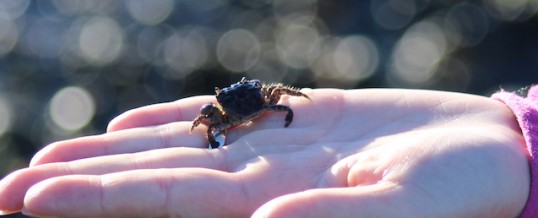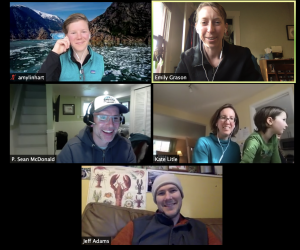
March 31, 2020
March and April are typically the busiest months on the Crab Team annual calendar, as staff and volunteers reunite for training workshops to relaunch the monitoring season. This spring, however, the Crab Team office has been almost entirely empty over the past month. The leadership of Washington Sea Grant, in collaboration with the UW College of the Environment, is following all advice and directives set forth for safety and health by the University of Washington around the COVID-19 outbreak. Without a doubt, the safety and health of individuals and community remains the most important consideration right now. As a result, and with an abundance of caution, it was decided to cancel all training workshops scheduled for both new and returning volunteers. Following Governor Inslee’s “Stay Home, Stay Healthy” order, all Crab Team activities outside of the home, for both staff and participants, have been temporarily suspended through at least April 9th. (*Edited for clarity)

Crab Team meetings are still just as fun as ever! Amy, Emily, Sean, Kate and Jeff are keeping up the hard work via Zoom.
This new reality has come at a particularly crucial point in our efforts to manage invasive European green crabs statewide. With the new detections at Drayton Harbor and Lummi Bay last fall and increasing concern on the outer coast, the perception of risk of a damaging invasion has been substantially increased. Several populations are poised to grow rapidly without intervention and now may be a critical time for trapping. We have evidence from Dungeness Spit, where removal trapping has been conducted by U.S. Fish and Wildlife Service for the past three years, that mid-spring can be the most efficient time of the year to trap and remove crabs. Additionally, over the winter, Crab Team staff has been working hard with Washington Department of Fish and Wildlife (WDFW) and other management partners to develop plans for increasing response capacity across the entire state. We have all been very eager to get out on the mud and capitalize on the momentum in interest, resources and knowledge built over the past five years. We don’t want to miss what feels like a unique and ephemeral window of opportunity to effectively thwart an invasion by this globally-damaging species. Rest assured that Crab Team HQ never sleeps and we’ll be right back out in the mud as soon as we’re able.
So, what can Crab Team do in the near-term? Like nearly everyone in this moment of history, Crab Team is trying to stay nimble. We continue whatever work we can still safely do to protect Washington shorelines from the emerging invasion by European green crabs. Though we know it might change (again), we wanted to share our current strategy for Crab Team activities this year.
Right now we are:
- Collaborating with management partners on preparations. Even from our home offices, we continue to work with partners and identify pieces of the puzzle that we can put in place now, so that removal trapping efforts in places like Drayton Harbor can get going as soon as possible and scale up quickly. The goal will be to take advantage of as much of the trapping season as possible when restrictions are lifted and training and field work can resume.
- Maintaining communications with volunteers and partners. Crab Team staff are staying in close contact with volunteers to address targeted needs and individual barriers to sampling, while keeping 250 participants informed and up to date on what to expect this season. We’ll continue our newsletters and social media presence, so everyone stays engaged on all things Crab Team.
When it is safe and advisable to do so, we plan to:
- Resume monitoring by experienced volunteers. Most sites in the Crab Team network have at least a few experienced volunteers in early detection protocols that can launch monitoring as soon as restrictions are lifted and it is safe to do so. To that end, staff spent much of March getting bait and materials to volunteers, so they are ready to get rolling as soon as possible.
- Reschedule workshops. We’ve learned over the years that, given the complexity of Crab Team protocols, distance learning (i.e. online training resources) for both new and continuing volunteers is not a sufficient replacement for in-person workshops. So, we plan to reschedule all workshops that were canceled to get new volunteers on board, and reconnect with continuing participants.
It’s not lost on many invasion biologists, or Crab Team volunteers, that some of the patterns and processes used to describe the spread of the virus are similar to the way we talk about invasive species. The value of finding cases while they are still extremely rare, and controlling them before the impacts are observed on a large scale (AKA early detection – rapid response), are cornerstones of invasion management. We know that the eagerness we feel to do this work as soon as possible is shared by everyone working on European green crab management, and we feel positively buoyed by that energy. But we also know that these efforts will require the entire community, so protecting the health of that community right now is the indisputable priority.
As always, Crab Team staff are truly awed and humbled by the commitment and grace demonstrated by volunteer and partner monitors, and all those who support efforts to protect Washington shorelines from European green crabs. We seriously – and we cannot stress this enough – cannot wait to get out on the mud again with you!
-Emily Grason
Header photo credit: Jeff Adams
APR
2020